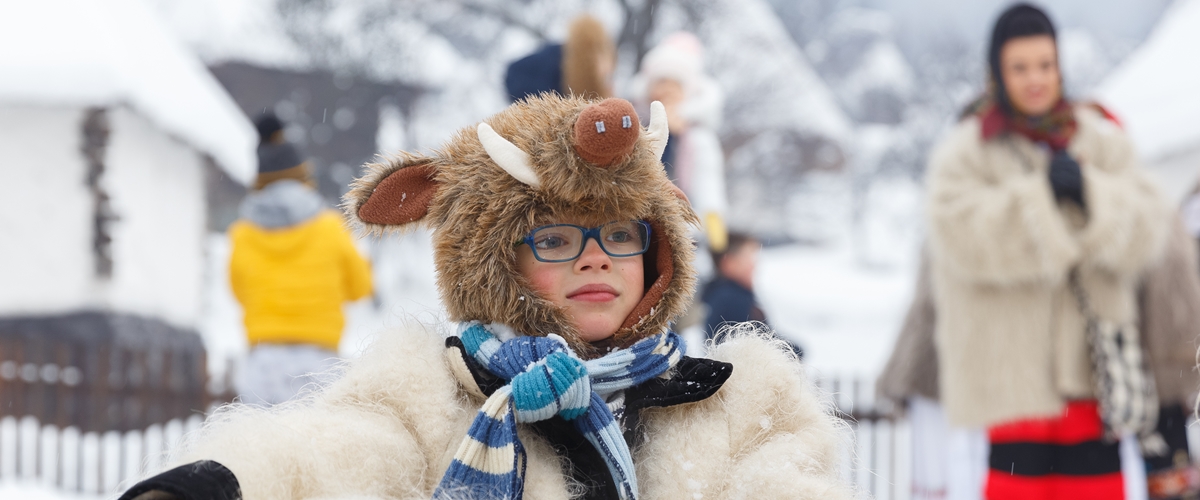Winter Customs in Romania
When it comes to customs and superstitions, Romania is a rich country.
The Dance of the Bear. One of the most impressive is the Bear Dance. Every December, the 'dancing bears festival' takes place, beginning in the days before Christmas and finishing on New Year's Eve. Hundreds of people dressed as bears of all ages tour villages and towns, dancing to the thunderous sound of drumbeat. Traditionally, the parade would visit every family in the community, accompanied by up to three singing bear tamers, many characters dressed in women's clothing, and drummers. People in what is now northeastern Romania would dress in bear skins and dance to ward off bad spirits hundreds of years ago. The ritual is still practised today as a prominent tourist attraction.
Pig Slaughtering. The custom is not a sign of cruelty, and its goal is not "entertainment." This is how Romanians used to sacrifice pigs to feed their family during the holidays. The entire pig killing process is unique, not because of how the pig is slain, but because of what happens afterwards. The entire family pitches in to prepare the food for the Christmas dinner. The pigs are slaughtered on December 20th, St. Ignatius' feast day. There are just four days left after the sacrifice to prepare the flesh, create sausages, melt the fat, and further preparations.
Caroling. Romanian Christmas Carols is a collection of traditional Romanian village Christmas songs sung by small groups of youngsters. Children walk through their community on Christmas Eve, singing songs from home to house. The hosts reward them with sweets, fruits, and money as a token of appreciation for their efforts. On Christmas Day, adults also go carol singing. The origins of Romanian Christmas songs vary. While some carols centre on the birth of Jesus, others seem more like blessings for the carol singers and their families. The majority of these Christmas carols wish people health, happiness, and love in the next year. Sung by Ștefan Hrușcă, Romania’s most famous singer of Christmas music, the song is titled Afară ninge liniştit or “Outside, the snow is quietly falling.”
Christmas. Christmas is a significant yearly event in Romania, noted on December 24/25, as it is in other Christian countries. The Birth of Jesus is greeted with delight, but it also brings with it a variety of very old practises that commemorated the Winter Solstice, the moment when nature provides hope that it will be renewed. Romanians begin the last Christmas preparations on December 20, Saint Ignatius Day. They cut pigs for Christmas Eve supper on this date.People frequently buy their Christmas trees around this time from public markets or shops. It is Noaptea de ajun on December 24, the day when youngsters generally begin carolling their neighbours. Women create traditional cookies on the same day to offer to youngsters who are carolling. The Christmas tree should normally be decorated by then. Music plays an essential role in Romanian Christmas celebrations. There is a distinct musical style that is similar to Christmas carols but with more traditional / Christian lyrics. During the Christmas season, Romanians create or purchase a variety of unique delicacies, including desserts and sweets. Cozonac (spongecake) is a type of Panetone consisting of flour, yolks, yeast, and a variety of additional ingredients, flavours, sauces, and additives. Spongecakes come in a variety of flavours and hundreds of recipes. You may knead it for hours if you want it ready in 6 hours, or you can let it rise for 1 hour if you don't want to knead it. The sponge cake can be filled with walnuts, chocolate, raisins, Turkish delight, or, in Transylvania, poppy seed paste (cozonac cu mac). Plates piled high with little pastries and cakes (corni şi baclava) are ready to offer carollers when they arrive. A moulded vegetable and chicken salad with mayonnaise and olives and cooked eggs is frequently served. Although it is named Salată de boeuf in French, it generally does not contain meat. Piftie, sarmale, and pork dishes are among the other Christmas delicacies.




.png)



